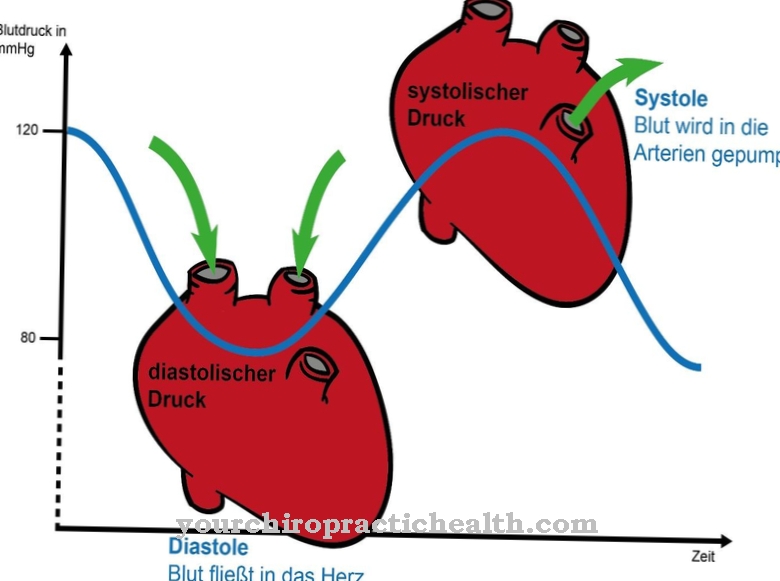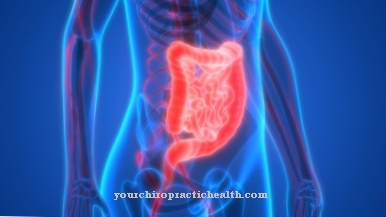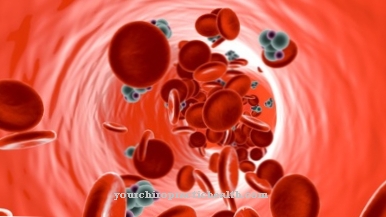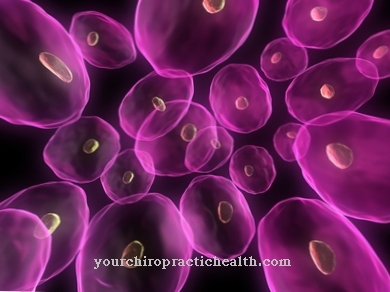The oral preparation phase is part of the swallowing process and makes a bite of food ready to swallow. This phase is followed by the oral transport phase, during which the swallowing reflex is triggered. Oral preparation disorders are, for example, abnormal saliva production.
What is the oral preparation phase?

The act of swallowing is a human reflex that is triggered by touch stimuli in the area of the base of the tongue. In the narrower definition, the swallowing process consists of three transport phases. The triggering of the swallowing reflex is at the end of the first, the so-called oral transport phase.
In order for the oral transport phase to begin, however, the food must first be chewed to a pulp and mixed with saliva. This process takes place during the oral preparation phase. In the broader definition, the oral preparation phase is part of the act of swallowing. In the narrower definition, the phase is considered separately from the act of swallowing.
Overall, processes take place in the oral preparation phase that make swallowing possible in the first place. The product of the preparation phase is a bolus of food that holds between five and 20 milliliters and is mixed with saliva.
In addition to the salivary glands, the masticatory muscles, the teeth, the teeth, the lips, the temporomandibular joint and the tongue are involved in the oral preparation phase.
Function & task
The oral preparation phase immediately follows the intake of food or overlaps with it. The food is taken up in the mouth, which is mainly due to the lips. It is broken up by the teeth when the masticatory muscles contract. The chewing movement corresponds to a rotational movement, which is made possible by an ideal coordination of jaw, tongue, cheek and hyoid bone movements.
When chewing, the tongue rotates in the direction of the preferred chewing side. When chewing, the soft palate is also directed forward to close off the oral cavity to keep the food in the mouth. If the back of the pharynx were not closed by the soft palate, the food bolus would trigger the swallowing reflex much earlier.
The cheek muscles also take on important tasks when chewing. The muscles remove food residues from the cheek pockets and help transport food to the tongue. Meanwhile, the salivary glands produce saliva, which is mixed with the food when chewed and gives the bite glide. The ready-to-swallow bolus of food is placed on the tongue. At this point, the oral preparation phase overlaps with the oral transport phase, which is now being initiated.
The texture, taste, temperature and volume of the food are determined on the middle third of the tongue. This process is made possible by sensory cells of the skin and the gustatory sense, which bind to molecules of temperature and taste, whereby the tongue assesses the consistency and shape of the food by touch.
At the end of the phase, the tongue forms a ready-to-swallow bite from the food and stabilizes the bolus with the tongue bowl in the middle of the palate. With these steps, the oral preparation phase plays a role especially for solid foods. The tongue forwards liquids directly in the direction of the throat.
Unlike the subsequent phases of the swallowing process, the oral preparation phase can be controlled at will. This means, for example, that each person determines for themselves how long they chew. Only the saliva production of the salivary glands eludes voluntary influence.
You can find your medication here
➔ Medication for bad breath and bad breathIllnesses & ailments
The oral preparation phase can be disrupted by pathological processes. One example of this is hyposalivation. In this disease, the saliva production of the salivary glands is sometimes reduced by more than 50 percent. Extreme hyposalivation promotes dry mouth and leads to swallowing disorders, as the food bolus does not have sufficient gliding ability in the oral preparation phase. To a certain extent, hyposalivation is an age-physiological phenomenon, as less and less saliva is produced as we get older. Medicines such as cytostatics also favor the appearance.
In addition, the underproduction of saliva can be the symptom of a higher-level disease, for example the symptom of AIDS or sepsis. In addition, patients receiving radiation treatment also suffer from reduced saliva production.
The opposite of this is hypersalivation, in which excessive amounts of saliva are produced. For example, hypersalivation can be linked to excessive consumption of chewing gum. Parkinson's, infections, inflammation or poisoning are also often associated with overproduction of saliva. This phenomenon also interferes with the oral preparation phase, especially when the saliva flows uncontrollably towards the throat and the patient chokes on it.
Not only an abnormal activity of the salivary glands, but also a violation of the muscle groups involved in the preparation phase, the soft palate, the teeth or the lips make the preparatory process for the act of swallowing more difficult. In the case of congenital malformations such as the cleft lip and palate, for example, disorders occur.
If the soft palate is affected by dysplasia (malformation), this can have the most serious consequences. The throat can then possibly no longer be closed by the anatomical structure while chewing. The swallowing reflex is triggered earlier. However, since the food is not yet ready to swallow, patients often choke.
Apart from the difficulties described, neurogenic disorders can also disrupt the coordination of the individual movements when chewing. The cause of such a phenomenon is either a central or peripheral lesion of nerve tissue. In the central nervous system, multiple sclerosis is often the cause of such lesions. In the peripheral nervous system, for example, a polyneuropathy can be to blame. All swallowing disorders are summarized under the term dysphagia.



























